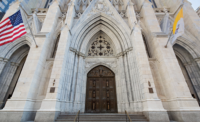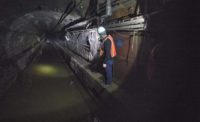After drilling deep into the bedrock beneath New York City, crews are nearing completion on a geothermal installation beneath St. Patrick’s Cathedral. A $177-million renovation of the 137-year-old Gothic Revival cathedral was finished in mid-2015, but less-visible work to install a geothermal system continued into 2016.
“Drilling wells like this in the middle of Manhattan, it hasn’t necessarily been done before,” says Michael Graniello, vice president of StructureTone, which is managing the project. “There are other geothermal installations in New York City, but none quite as big or elaborate.”
The open-loop geothermal system consists of 10 standing-column, 8-in.-dia wells drilled to an average depth of 1,800 ft, with the deepest at 2,020 ft. Eight modulating heat-recovery chillers will heat and cool all four buildings on the cathedral’s campus.
“At the outset, we evaluated a conventional HVAC system, but it would pose too many challenges for this historic building,” says Rich Sileo, senior engineer with Landmark Facilities Group, MEP engineer. “We did a feasibility study and found a geothermal system let us meet our goals with the smallest impact.”
“The two drivers were designing and installing an efficient system, as well as limiting the impact on the historical site,” says Julie Geden, vice president of Zubatkin, which served as owner’s rep.
The geothermal system was designed to minimize maintenance, as well, a requirement from the Archdiocese of New York, the owner. “There is a plate-frame heat exchanger at each well,” says Sileo. “The allows us to keep the geo-thermal well water, also called condenser water, independent from the surface system.” The heat exchanger isolates the well water from the surface, simplifying operations, says Sileo. “Because we did this, there’s no need to use glycol or other freeze protection or worry about the water quality from the wells. It’s an important design feature of the system.”
According to Sileo, the entire campus, including the cathedral, requires 240 tons of cooling, with total demand on the HVAC system at 3,200 MBH (one MBH is one thousand BTUs per hour).
Work on the project began in March 2015, and well drilling was completed in January 2016. Subcontractor William Stothoff Co.’s drilling required the removal of 486 cu yd of rock, and the careful positioning and transportation of an 80,000-lb track-mounted drill rig in and out of the narrow yards on either side of the cathedral. “We had to build a specifically engineering ramp to get the rig onto the site,” recalls Graniello. “Had to shut down Fifth Avenue a few times. We tried to minimize disruption.”
Crews now are completing the trenching and horizontal drilling to link together the wells at the surface—work that is especially sensitive, as it passes through the foundations of the cathedral building.
Cost-efficiency was not the project’s top priority. “We weren’t thinking of immediate payback on this project, something that’ll work 20 years and then you rip it out,” says Sileo. “With St. Patrick’s Cathedral, this is a structure that will continue to last for centuries, so we looked for a system that would offer long life with a minimal impact to the building.”
After the geothermal system is fully installed and tested, a lengthy certification process will begin. The project is expected to be fully completed in Q1 2017.






